
HPU2. Nat. Sci. Tech. Vol 02, issue 03 (2023), 19-33
HPU2 Journal of Sciences:
Natural Sciences and Technology
journal homepage: https://sj.hpu2.edu.vn
Article type: Research article
Received date: 13-10-2023 ; Revised date: 17-11-2023 ; Accepted date: 01-12-2023
This is licensed under the CC BY-NC-ND 4.0
Algorithm optimizing profitability in the
manufacturing industry
Kim-Thanh Tran Thi*
University of Economics - Technology for Industries (UNETI), Ha Noi, Viet Nam
Abstract
This article focuses on optimizing profitability in the manufacturing sector by integrating critical
elements such as production, pricing, resource allocation, and cost analysis. Through preliminary
steps, the article proposes a complex mathematical model to maximize profit by making intelligent
decisions regarding production and pricing. Predicting demand, analyzing costs, and allocating
resources appropriately play crucial roles in achieving this goal. The article also underscores the
importance of risk management and adaptability in a volatile market environment, ensuring sustained
competitiveness and profitability.
Keywords: algorithm, optimizing profitability, production, pricing, resource allocation, cost analysis
1. Introduction
In an increasingly interconnected and globalized world, international trade plays a pivotal role in
shaping the economic landscape of nations. The intricate dynamics of trade relations, coupled with the
challenges of economic development, demand rigorous analysis and informed decision-making.
Mathematics, with its precision and versatility, offers a powerful toolset for dissecting the multifaceted
intricacies of international trade and economic development. This paper embarks on a journey to
explore how applied mathematics can significantly contribute to our understanding of the
* Corresponding author, E-mail: ttkthanh@uneti.edu.vn
https://doi.org/10.56764/hpu2.jos.2023.2.3.19-33

HPU2. Nat. Sci. Tech. 2023, 2(3), 19-33
https://sj.hpu2.edu.vn 20
consequences and potential solutions associated with international trade and economic development.
By leveraging mathematical models, statistical techniques, and optimization methods, this research
aims to shed light on the complex interplay of factors that influence trade patterns and economic
growth. In doing so, it seeks to provide insights that can guide policymakers, businesses, and
researchers in making informed choices to promote sustainable development, enhance global trade
relationships, and ultimately foster prosperity on a global scale.
The realms of international trade and economic development have been inextricably intertwined
for centuries. As nations engage in trade, they exchange goods, services, and resources, creating
interdependencies that can significantly impact their economic well-being. Furthermore, the process of
economic development is intricately linked to a nation's ability to engage effectively in international
trade. This relationship has given rise to a complex web of economic theories, policy frameworks, and
empirical studies aimed at deciphering the intricate dynamics at play. Yet, as globalization deepens
and trade patterns evolve, the traditional approaches to understanding and managing these interactions
are often rendered insufficient. To address this challenge, a growing body of research is turning to
applied mathematics as a means to provide deeper insights and more robust decision-making tools in
the realm of international trade and economic development.
2. Preliminaries
Mathematical models have long played a pivotal role in understanding complex systems and
predicting their behavior. In the context of international trade, these models offer a structured
approach to analyze various factors such as tariffs, trade agreements, exchange rates, and market
conditions. Through the lens of mathematics, researchers can simulate and assess different trade
scenarios, quantify the impact of policy changes, and identify optimal strategies for countries to
maximize their gains from trade. Similarly, in the sphere of economic development, mathematical
models can be used to evaluate the effectiveness of development policies, allocate resources
efficiently, and address pressing issues such as poverty reduction and sustainable growth. By
integrating mathematical rigor with economic intuition, this research endeavors to bridge the gap
between theory and practice in international trade and economic development.
As the global community confronts a myriad of economic challenges, from the fallout of the
COVID-19 pandemic to climate change and income inequality, the role of applied mathematics
becomes increasingly pivotal. This paper embarks on a comprehensive exploration of this intersection,
aiming to provide both theoretical insights and practical guidance. It is our belief that by harnessing
the power of mathematics, we can unlock new possibilities for addressing the complexities of
international trade and economic development, ultimately paving the way for a more prosperous and
interconnected world. This study represents an important step towards realizing that vision, as it seeks
to unravel the intricate tapestry of global economics through the lens of mathematics, offering fresh
perspectives and innovative solutions for the challenges that lie ahead.
Mathematics plays a pivotal role in the field of economics, offering a powerful set of tools and
techniques that are instrumental in addressing complex economic challenges. The significance and
importance of applying mathematical tools in economic problem-solving cannot be overstated.
Mathematics provides a level of precision and rigor that is essential in economic analysis. It allows
economists to formulate theories, models, and hypotheses with clarity, ensuring that economic
concepts are well-defined and logically consistent. Economic systems are inherently complex,
involving numerous variables and interdependencies. Mathematical models can distill this complexity

HPU2. Nat. Sci. Tech. 2023, 2(3), 19-33
https://sj.hpu2.edu.vn 21
into manageable frameworks, enabling economists to study and understand economic phenomena
systematically. Mathematics enables economists to conduct quantitative analysis, which is crucial for
making informed decisions. Whether it's estimating the impact of a policy change, forecasting
economic trends, or evaluating investment options, quantitative tools provide concrete insights backed
by data.
In addition, optimization techniques in mathematics are used to find the best solutions to
economic problems, such as maximizing profits, minimizing costs, or allocating resources efficiently.
These methods help businesses and policymakers make decisions that are economically sound.
Statistical methods, a branch of mathematics, are extensively used in economics to analyze and
interpret economic data. From regression analysis to hypothesis testing, these tools allow economists
to draw meaningful conclusions from empirical observations. Mathematical models are essential for
assessing the consequences of economic policies. They enable policymakers to simulate various policy
scenarios, understand potential outcomes, and weigh the trade-offs involved in decision-making. In an
increasingly globalized world, international trade and economic interactions are complex and
multifaceted. Mathematical models and network analysis help economists make sense of these
intricate relationships and predict their consequences. Moreover, efficient allocation of resources is a
fundamental economic challenge. Mathematical programming and optimization models guide
decisions on resource allocation, leading to better utilization of scarce resources. Economics often
involves risk assessment and management. Mathematical tools, such as probability theory and
stochastic modeling, are employed to quantify and mitigate risks in economic decisions. Mathematical
innovation drives the development of new economic theories and the design of novel policies. For
example, the field of behavioral economics draws heavily on mathematical psychology to understand
human decision-making.
3. Results
Optimizing Production and Pricing for a Manufacturing Company is an important problem in
economy. A manufacturing company produces a variety of products and is seeking to maximize its
profits. The company faces several challenges, including fluctuating demand, production constraints,
and the need to set optimal product prices to remain competitive in the market. The initial step in
addressing the problem of optimizing production and pricing for a manufacturing company is to gather
comprehensive data and perform a thorough analysis. Data collection and analysis are fundamental as
they provide the foundation for subsequent decision-making processes.
3.1. For data gathering and For data analysis
Begin by collecting historical sales data for each product in the company's portfolio. This data
should include information on sales volumes, prices, and revenue generated over a significant time
period, ideally covering several years.
Alongside sales data, obtain information regarding market conditions during the same time frame.
Market conditions encompass economic indicators, competitor behavior, and any industry-specific
factors that may have influenced sales trends.
Collect detailed information on the characteristics of each product. This may include production
costs, specifications, features, and any other attributes that could impact demand or production.
Identify and record external factors that could influence demand for the company's products.
These may include economic indicators (e.g., GDP growth, inflation rates), consumer sentiment, and
regulatory changes.

HPU2. Nat. Sci. Tech. 2023, 2(3), 19-33
https://sj.hpu2.edu.vn 22
Document production constraints and limitations, such as resource availability, production
capacity, and workforce constraints. These constraints are crucial for later stages of optimization.
Prior to analysis, it's essential to clean and preprocess the collected data. This involves identifying
and addressing missing values, outliers, and inconsistencies in the dataset.
Perform EDA to gain initial insights into the data. Visualizations, such as histograms, scatter
plots, and time series plots, can help identify patterns, trends, and seasonality in sales data.
Utilize statistical methods to quantify relationships within the data. Calculate key statistical
measures, such as mean, median, and standard deviation, to characterize central tendencies and
variability.
Apply time series analysis techniques to capture seasonality and trends in demand. Methods like
moving averages, exponential smoothing, and autoregressive models can be used.
Explore the relationships between variables. For instance, determine if there is a correlation
between changes in product prices and sales volume.
Develop mathematical models for demand forecasting. Time series models, econometric models,
or machine learning algorithms can be used to predict future demand based on historical data and
relevant predictors.
If the company's product portfolio is diverse, consider segmenting the data to analyze each
product category or segment separately. This allows for more tailored analysis and decision-making.
If there are specific hypotheses or questions about the data, conduct hypothesis testing to validate
or refute these hypotheses. For example, test whether changes in economic indicators have a
statistically significant impact on sales.
Create informative visualizations, including graphs, charts, and heatmaps, to present key findings
to stakeholders. Visual representations can help convey complex insights more effectively.
3.2. Demand Forecasting
Develop a mathematical model to forecast future demand for each product. Time series analysis
or econometric modeling can be used for this purpose. Consider external factors such as economic. In
the quest to optimize production and pricing for a manufacturing company, it's crucial to consider
external factors that can significantly influence demand for products. While we've already discussed
developing mathematical models for demand forecasting in Step 1, this step focuses on the integration
of external factors such as economic indicators, market competition, and consumer preferences into
the forecasting process.
Identify Relevant External Factors:
Begin by identifying the external factors that are likely to affect demand for the company's
products. Consider a range of factors, including:
Economic Indicators: Key economic variables such as GDP growth, inflation rates,
unemployment rates, and consumer confidence indices. These indicators provide insights into the
overall economic health of the market and consumer sentiment.
Market Competition: Analyze the competitive landscape by considering factors such as the prices,
promotional activities, and market share of competitors. Understand how competitors' actions might
impact your market position.
Consumer Preferences and Trends: Stay attuned to changing consumer preferences, emerging

HPU2. Nat. Sci. Tech. 2023, 2(3), 19-33
https://sj.hpu2.edu.vn 23
trends, and technological advancements that may affect the demand for specific products or features.
Regulatory Changes: Monitor any regulatory changes or government policies that could impact
the industry, such as changes in import/export tariffs or environmental regulations.
Seasonal Effects: Recognize seasonality and holidays that may affect demand patterns. For
instance, sales of certain products may spike during holiday seasons.
Supply Chain Disruptions: Assess the risk of supply chain disruptions due to factors like natural
disasters, political instability, or logistical challenges.
Demographic Shifts: Changes in the demographics of your target market can influence demand.
For example, an aging population may have different consumption patterns than a younger one.
Data Collection and Integration:
Once you've identified the relevant external factors, gather data on these factors over the same
time period as the historical sales data. Ensure that the data is accurate, up-to-date, and compatible
with the timeframe of the demand data.
Economic Data: Obtain economic data from reputable sources such as government agencies,
central banks, or economic research organizations. This data should cover the relevant economic
indicators over the historical and forecast periods.
Competitor Data: Gather data on your competitors' pricing strategies, market share, and
promotional activities. Publicly available reports, market research, and industry publications can be
valuable sources.
Consumer Surveys: Conduct surveys or analyze existing consumer surveys to gain insights into
changing consumer preferences and behavior. This can provide qualitative data to complement
quantitative analysis.
Regulatory Information: Stay informed about regulatory changes and their potential impact on
your industry. Legal databases and government publications can be useful sources.
Model Specification:
With the external data in hand, you'll need to specify an econometric model that relates demand
to the identified external factors. The choice of model depends on the nature of the data and the
relationships between variables. Common model types include:
Linear Regression: A straightforward model that assesses how changes in external factors relate
to changes in demand. The coefficients represent the impact of each external factor on demand.
Panel Data Analysis: Useful when dealing with time series data for multiple products or regions.
It accounts for both time and cross-sectional variations.
Structural Models: More complex models that incorporate economic theories and structural
equations to explain demand variations.
Estimation and Validation:
Estimate the parameters of the econometric model using techniques such as Ordinary Least
Squares (OLS) or maximum likelihood estimation. Ensure that the model captures the influence of
external factors on demand.
Evaluate the model's goodness of fit and statistical significance of coefficients. Assess the model's
ability to explain variations in demand using appropriate statistical tests.


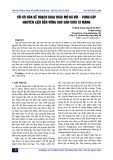

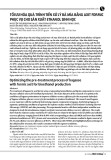
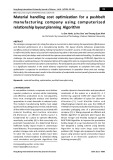
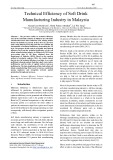
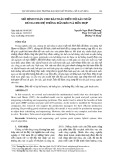
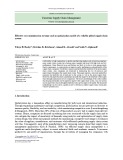
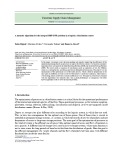



![Tối ưu hóa hiệu suất hệ thống: Bài thuyết trình [Chuẩn nhất]](https://cdn.tailieu.vn/images/document/thumbnail/2025/20251107/hiepdz2703@gmail.com/135x160/35941762488193.jpg)




![Bài giảng Quản trị chất lượng trong công nghiệp thực phẩm [chuẩn nhất]](https://cdn.tailieu.vn/images/document/thumbnail/2025/20250805/vijiraiya/135x160/637_bai-giang-quan-tri-chat-luong-trong-cong-nghiep-thuc-pham.jpg)

![Đề cương bài giảng Kỹ năng hoạt động công nghiệp [mới nhất]](https://cdn.tailieu.vn/images/document/thumbnail/2025/20250715/kimphuong1001/135x160/76971752564028.jpg)


![Bài giảng Kỹ thuật điều độ trong sản xuất và dịch vụ [mới nhất]](https://cdn.tailieu.vn/images/document/thumbnail/2025/20250630/dcbaor/135x160/13121751251866.jpg)


